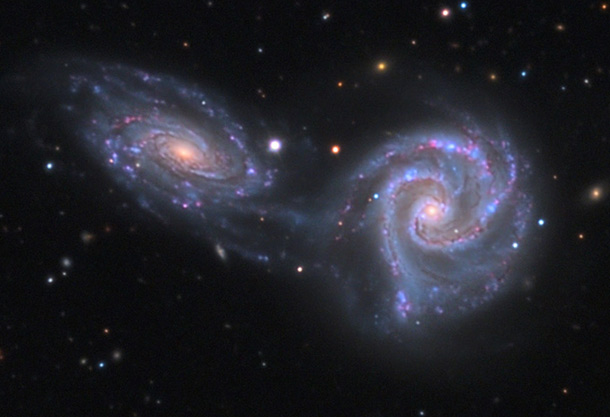Create a free profile to get unlimited access to exclusive videos, sweepstakes, and more!
The start of a long, long dance

A hundred million light years away, two gorgeous spiral galaxies are locked in an embrace that may end with them merging, a dance spread across a hundred thousand light years in space and a hundred million years of time.
[Click to galactinate, and yeah, just do it. The hi-res version is big and lush and lovely indeed.]
This image, taken by frequent BABlog contributor Adam Block, shows this cosmic waltz in lovely detail (another wonderful image is available via the ESO as well [UPDATE: ... and from Gemini, with a diagram of the two and a nice explanation]). The two galaxies (NGC 5426 on the left, and NGC 5427 on the right) are just starting this eons-long encounter, but affects are already visible. You can see tendrils of material stretching from NGC 5426 to its companion, drawn out by the force of NGC 5427's gravitational attraction.
Inside the galaxies, you can easily see the pink glow of gas clouds, disturbed by the interaction, starting to furiously churn out hot young stars. Actually, stars of all masses are born in these clouds, but it's the rare massive stars that have the most impact. They blast out ultraviolet light which makes the gas glow, and will explode as supernovae, lighting things up even more.
In galactic collisions like this the outcome can be difficult to ascertain. Perhaps they'll pass this one time and do so with sufficient velocity to make this a one-eon stand, continuing on into the night. Or, if their relative speeds aren't enough, they'll pull apart, only to be drawn inexorably together once again. Even then they may pass, but this time in an ever-decreasing arc, until finally they merge into one bigger galaxy. Although this plays out over far too long a timespan to watch in real time, we see so many colliding galaxies that it's like having snapshots at all different stages of evolution (see Related Posts below for lots of collidey goodness).
The general steps here are known, but the specific outcome of this particular encounter is still to be seen.
And we'll see something like it up close, if not for quite some time: the Andromeda Galaxy will one day collide with our Milky Way, and when that happens we'll be able to see what a galactic collision looks like... from the inside. Buy your tickets now. The show begins in just a billion years or two.
Image credit: Adam Block/Mount Lemmon SkyCenter/University of Arizona
Related Posts:
- Desktop Project Part 25: Chaos in a galactic nursery
- Sometimes a cigar galaxy is just a cigar galaxy
- Galaxy cluster collision makes a splash⦠a million light years long!
- First light for ALMA
- Gorgeous galaxies celebrate Hubbleâs 21st birthday
- The delicate aftermath of cosmic violence



























